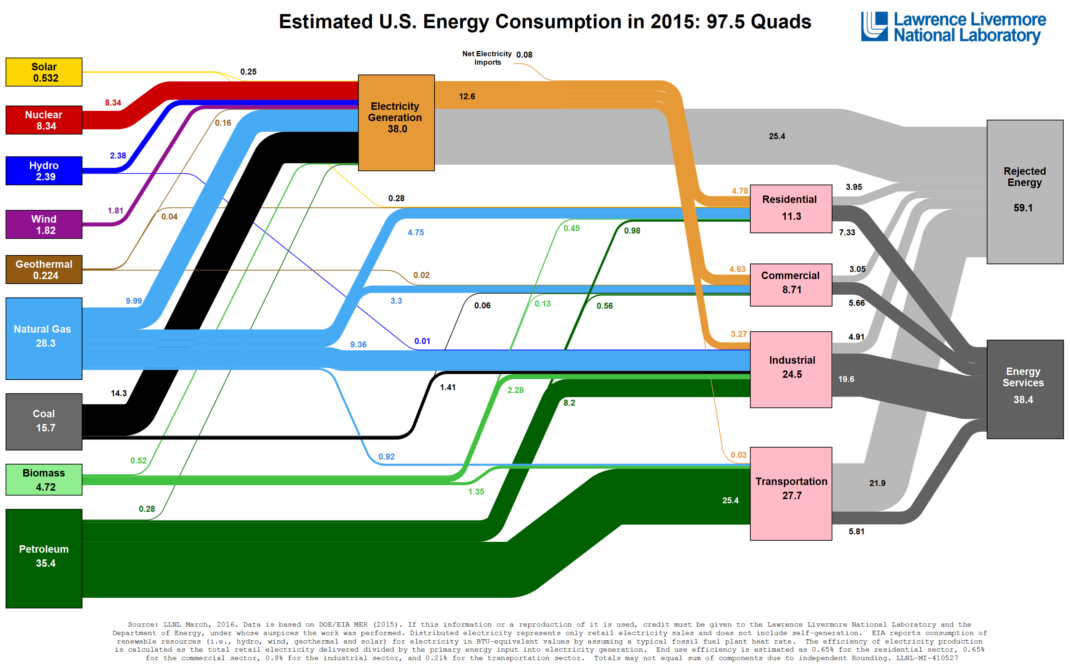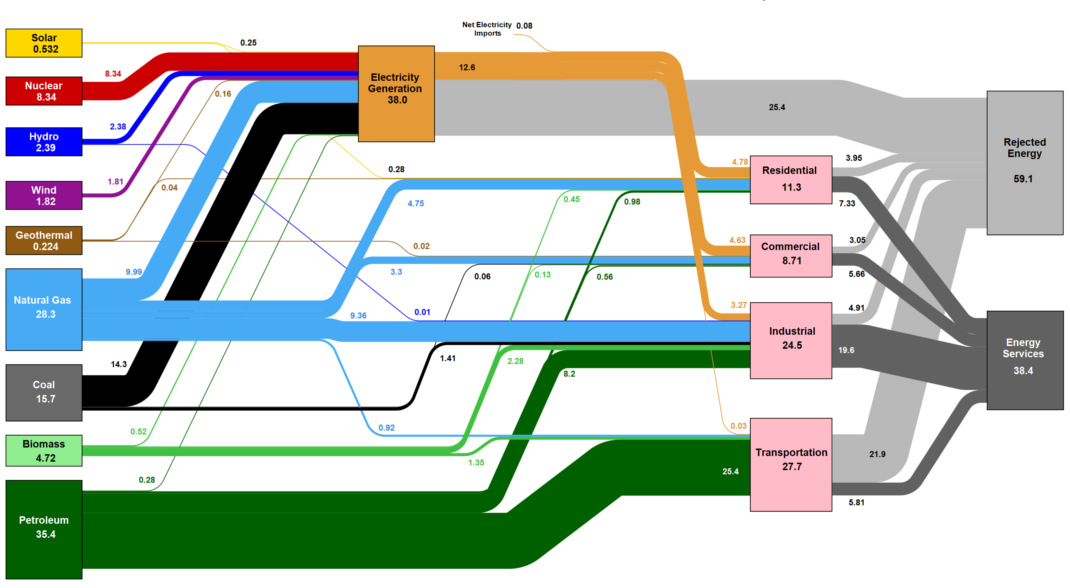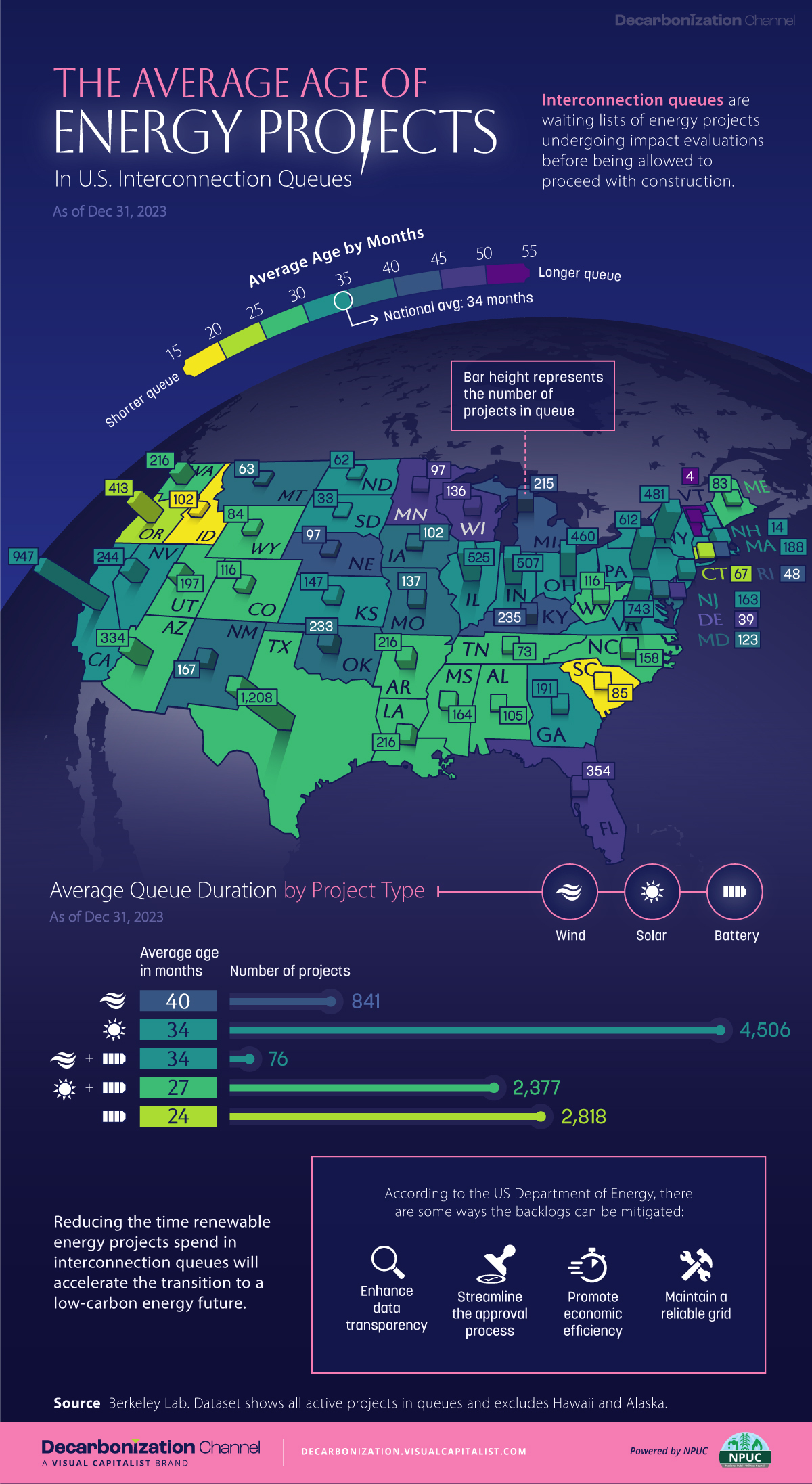Energy
All U.S. Energy Consumption in a Giant Diagram

All U.S. Energy Consumption in a Giant Diagram
Today’s graphic is special type of flow chart, called a Sankey diagram.
This particular one shows the total estimated energy consumption in the United States in 2015, and how energy flowed from source to the final destination. The graphic comes to us from the Lawrence Livermore National Laboratory and the Department of Energy.
The beauty of a Sankey is in its simplicity and and effectiveness. No information is left out, and we can really see the full energy picture from a 10,000 foot view.
Wasted Effort
The U.S. is estimated to have consumed 97.5 quads of energy in 2015.
What’s a quad? It’s equal to a quadrillion BTUs, which is roughly comparable to any of these:
- 8,007,000,000 gallons (US) of gasoline
- 293,071,000,000 kilowatt-hours (kWh)
- 36,000,000 tonnes of coal
- 970,434,000,000 cubic feet of natural gas
- 25,200,000 tonnes of oil
- 252,000,000 tonnes of TNT
- 13.3 tonnes of uranium-235
It’s a lot of energy – and if you look at the diagram, you’ll see most of it is actually wasted.
It’s estimated that 59.1 quads (60.6% of all energy) is “rejected energy”, a fancy term for energy that is produced but not used in an effective way. For example, when gasoline is burned in a car, most of the energy comes off as heat instead of doing productive work (ie. turning the crank shaft). The average internal combustion engine is only 20% efficient, and people get excited even when they approach 40% efficiency.
While gas engines are horribly inefficient, so are other energy sources. If you look at electricity production on the diagram, you’ll see that 67% of all energy going to generate electricity is wasted.
It’s the laws of physics, but there are still many areas for improvement to increase this efficiency.
A Long Way to Go for Green Energy
As we explained in Part 2 of our Battery Series, there are still some big obstacles to overcome for green energy, batteries, and energy storage.
By looking at all energy use (including non-electrical energy used in automobiles, industrial, etc.), this diagram helps put things in even more perspective. To make a big impact, green energy not only has to make inroads in electrical generation, but it also has to supplant the 25.4 quads of energy being used in the automotive sector. This is why projects like the massive Tesla Gigafactory 1 are such a big deal. If Elon Musk is successful in his mission, the whole diagram and our energy mix would change dramatically.
For now, however, green is still a blip on the radar. Looking at total energy consumption in 2015, solar only accounted for 0.53 quads of energy. Meanwhile, wind accounted for 1.82 quads.
Energy
Mapped: The Age of Energy Projects in Interconnection Queues, by State
This map shows how many energy projects are in interconnection queues by state and how long these projects have been queued up, on average.

Age of Energy Projects in Interconnection Queues, by State
This was originally posted on our Voronoi app. Download the app for free on iOS or Android and discover incredible data-driven charts from a variety of trusted sources.
By the end of 2023, more than 11,000 energy projects were in interconnection queues in the United States, waiting for a green-light from regional grid operators to proceed with construction.
This map, created in partnership with the National Public Utilities Council, maps out the average age of active energy projects in interconnection queues by state, using data from Berkeley Lab.
Interconnection Queues, Explained
Interconnection queues are lists of energy projects that have made interconnection requests to their regional grid operators. Once submitted, these requests formally initiate the impact study process that each project goes through before grid connection, forming waiting lists for approval known as interconnection queues.
In recent years, both the number and generation capacity of queued projects have surged in the United States, along with the length of time spent in queue.
According to Berkeley Lab, the amount of generation capacity entering queues each year has risen by more than 550% from 2015 to 2023, with average queue duration rising from 3 years to 5 years the same period.
As a result of the growing backlog, a large proportion of projects ultimately withdraw from queues, leading to only 19% of applications reaching commercial operations.
The Backlog: Number of Projects and Average Wait Times
Of the 11,000 active projects in U.S. queues at the end of 2023, Texas, California, and Virginia had the most in queue; 1,208, 947, and 743, respectively.
When looking at the average ages of these projects, all three states hovered around the national average of 34 months (2.83 years), with Texas sporting 28 months, California 33, and Virginia 34.
Vermont, Minnesota, Wisconsin, and Florida, on the other hand, had the highest average queue durations; 54, 49, 47, and 46 months, respectively.
Average Queue Duration by Project Type
At the end of 2023, more than 95% of the generation capacity in active interconnection queues was for emission-free resources. The table below provides a breakdown.
| Project Type | Average Queue Duration (As of 12/31/2023) | Number of Projects in Queue |
|---|---|---|
| Wind | 40 months | 841 |
| Solar | 34 months | 4,506 |
| Wind+Battery | 34 months | 76 |
| Solar+Battery | 27 months | 2,377 |
| Battery | 24 months | 2,818 |
Wind projects had the highest wait times at the end of 2023 with an average age of 40 months (3.33 years). Solar projects, on the other hand, made up more than 40% of projects in queue.
Overall, reducing the time that these renewable energy projects spend in queues can accelerate the transition to a low-carbon energy future.
According to the U.S. Department of Energy, enhancing data transparency, streamlining approval processes, promoting economic efficiency, and maintaining a reliable grid are some of the ways this growing backlog can be mitigated.
-

 Wealth6 days ago
Wealth6 days agoCharted: Which City Has the Most Billionaires in 2024?
-

 Mining2 weeks ago
Mining2 weeks agoGold vs. S&P 500: Which Has Grown More Over Five Years?
-

 Uranium2 weeks ago
Uranium2 weeks agoThe World’s Biggest Nuclear Energy Producers
-

 Education2 weeks ago
Education2 weeks agoHow Hard Is It to Get Into an Ivy League School?
-

 Debt2 weeks ago
Debt2 weeks agoHow Debt-to-GDP Ratios Have Changed Since 2000
-

 Sports2 weeks ago
Sports2 weeks agoThe Highest Earning Athletes in Seven Professional Sports
-

 Science2 weeks ago
Science2 weeks agoVisualizing the Average Lifespans of Mammals
-

 Brands1 week ago
Brands1 week agoHow Tech Logos Have Evolved Over Time















